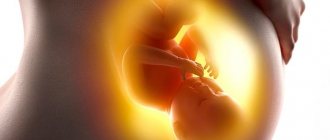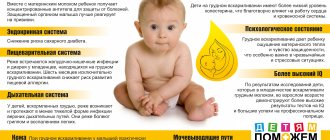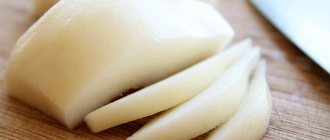Reasons for breastfeeding
The causes of green diarrhea in a breastfeeding baby may depend on completely different factors. For example, many mothers are confused and don’t know what to do when they see liquid green stool in their newborn. And the answer, in fact, is simple - in the first days of life, the baby’s body gets rid of meconium, feces, which was formed even when the child was in the womb. Just a couple of days and everything will return to normal.
But what other prerequisites are there for the occurrence of diarrhea with greens in an infant:
- If you find liquid green stool in your baby’s diaper, think about whether you really decided to change the diaper immediately after the baby had a bowel movement. Normal yellow baby feces, when exposed to air, tend to oxidize and acquire a greenish tint.
- The presence of green vegetables and fruits in the mother’s diet can give an unusual color to a child’s stool. Vegetables (for example, cucumbers or zucchini) have a stronger effect in this regard.
- When a child begins to receive complementary foods, the first to try are zucchini, broccoli and other green vegetables, since they are the least allergenic. This again cannot but affect the character and color of the stool. Eating vegetables makes stool looser.
- If the baby is sick, he will most likely be treated with medications. Some of them can turn the baby's stool greenish and make it more liquid. For example, iron-containing preparations have this property. Taking antibacterial drugs (antibiotics) disrupts the balance of microflora in the children's intestines. This condition is called dysbiosis, and with it, unusual color of stool and diarrhea are common.
- Actually, dysbiosis. In a small child, an imbalance of microflora can be provoked not only by taking antibiotics, as happens in adults (read more about green diarrhea in an adult in our other article). The baby’s body gets used to unusual conditions, and the intestines gradually acquire beneficial bacteria. It is very easy to upset the delicate balance; even the simplest addition of water during breastfeeding can provoke a malfunction and cause green diarrhea with mucus in the baby. But in general, this condition is typical for infants, because the little person’s intestines are still just developing. Some experts are of the opinion that, having discovered the presence of dysbiosis in a child, there is no need to take any measures to treat and eliminate this condition, since intervention may not only not help, but may even prolong it.
- Green, loose stool in a one-month-old baby can be caused by lactase deficiency (lactose or milk protein intolerance). This pathology can develop in a child after an intestinal infection. In this case, there is nothing left to do but transfer the baby to lactose-free dry formula.
- Liquid green foamy stool in a baby is typical if the baby receives more “fore” milk than “hind” milk. Foremilk is more watery, as opposed to hindmilk, which is fatty and filled with nutrients. If during feeding the mother often changes breasts, the baby eats too much “front” milk and simply does not get to the “back” milk. In this case, in addition to green diarrhea, the baby also experiences extremely little weight gain.
- Greens in stool may be due to increased secretion of bilirubin by the liver
- Green diarrhea in babies is a common occurrence during teething. In addition to the fact that stool liquefaction can be caused by increased salivation and, of course, swallowing saliva, during this period the child puts everything into his mouth, and just one poorly washed toy can lead to diarrhea, vomiting, and more serious troubles .
Infant chair. Is green stool a problem or normal for newborns?
During the first few months, the main task of a newborn baby's body is to digest breast milk and absorb all the nutrients it contains. A baby's stomach is very small at birth, but grows very quickly. If on the first day of life the baby is able to drink no more than 10 ml of milk, then by the 10th day he will calmly drink 70-80 ml.
Despite the fact that by the time of birth an infant has an already formed esophagus, it is short. At the same time, the sphincter, which should restrain food entering the stomach, still works weakly. As a result, all excess milk is safely regurgitated by the baby.
The structure of the internal organs of a newborn differs from that of adults. For example, the length of its intestines in relation to the length of its body is much greater. If the length of a child’s small intestine is approximately a meter, then in adults a similar organ has a length of no more than 10 cm. This is due to the need for the baby to adapt to lactotrophic nutrition.
Interesting. The mechanism of functioning of the digestive system starts in a newborn after the first attachment to the breast.
No matter how much the topic of young mothers’ interest in the contents of a diaper is ridiculed, in reality, the waste products of a baby are a good indicator of the state of his health. That is why their color, smell and consistency are so carefully analyzed by adults.
In matters of health, we are accustomed to focusing on a certain norm. If we talk about the stool of a newborn baby, it is impossible to call any single option the norm. The baby “has the right” to any stool, and if the child himself does not show any signs of illness, the mother need not panic.
For example, a baby’s original stool – meconium – is dark green, thick and viscous. Then, before the introduction of complementary foods, infants' feces are liquid and unformed. The stool of artificial babies is usually thicker and more uniform. Most of all, mothers are worried about the appearance of greenery, although in the vast majority of cases there is no reason to worry.
In children with any type of diet, green stool may be a consequence of some changes in the intestinal flora or simply a reaction to substances entering the body.
It is better to consider this issue in more detail separately for artificial babies and infants.
Few mothers know that after some time the contents of the diaper oxidize and its color changes. Therefore, you should not be surprised if, after a few hours, absolutely normal baby poop in a used diaper turns green.
So, if a child is given two breasts at one feeding, then he always receives only liquid, easily flowing milk, which he often choke on. And there is an imbalance in the intestines.
We began to solve this problem by giving the baby only one breast for 6-8 hours until it became light and empty. The flow from the second breast is of course a torrent, it needs to be expressed so that it is not so heavy from the milk overflowing it. And even from the breast that the baby is sucking, I express primary milk after 2-3 feedings so that thicker and whiter milk appears faster.
This is how our tummy problem is quickly solved: big changes in 2 days. The child feels much better, is happier, and is better nourished. Well, the butt is getting better
Infant stool is one of the problematic issues for many mothers. In the mid-20th century, as formula feeding became more common than breastfeeding, a new stereotype of “normal” bowel movements emerged. Formula-fed babies poop differently than infants: formula-fed stool is relatively infrequent, comes out formed and smells bad, reminiscent of adult stool.
* too frequent watery stools - from 12 to 16 bowel movements per day, with a strong odor, indicates that the child actually has diarrhea (diarrhea). You should definitely consult a doctor, and it is very advisable to continue breastfeeding, because breast milk best fills the deficiency of the substances necessary for the baby.
Green, watery, foamy stools are usually a sign of something called anterior-hindmilk imbalance, which doctors like to call “lactase deficiency.” True lactase deficiency is relatively rare, and in the vast majority of cases, this condition of the baby can be corrected by allowing each breast to be emptied completely before moving to the next.
In this case, the baby will receive a large portion of fatty “hind” milk, which contains little lactose (unlike the “front” portion that is rich in lactose) and is therefore easier to digest. Clarification so as not to get confused in terms: lactose is the milk sugar found in breast milk, and lactase is the enzyme that is required to break down lactose.
The reserves of lactase in the baby’s body are relatively small, and if he receives a lot of “foremilk”, then there is not enough lactase for its normal absorption, so the baby suffers from gas, and the stool takes on a characteristic appearance. Another problem that often arises after 5-6 weeks of a child’s life is relatively rare bowel movement, which is often mistakenly considered constipation and the baby begins to be actively treated.
At this age, milk finally becomes mature and the laxative colostrum component leaves it, and therefore most children begin to poop less often. Rare stool in itself is not a cause for concern; it’s just that the child’s body is figuring out how much it can accumulate in itself before pooping.
If the process is not interfered with, the child may not poop once or twice even for up to 7 days, after which the normal frequency will be restored. If you constantly interfere, forcing the intestines to empty when they are not yet ready, constipation will become habitual. BUT: Indeed, the child may not poop for up to a week, and the mother does not have to worry under one essential condition: the child ALSO does not worry! If this obviously bothers the child, the mother, of course, should not hope that everything will “work itself out.”
Regarding green stool in infants, I read in several places that this is the NORMAL if, in addition to the color, there is no pronounced bad odor or any other signs in the general condition of the child. It often happens that fresh stool is brownish-yellowish, and when it dries it turns green.
- A characteristic manifestation of dysbiosis in a newborn is a violation of stool, a change in its characteristic appearance. Dysbacteriosis can develop as a result of an intestinal infection, and therefore requires urgent medical attention.
- Often mothers pay attention to the smell of feces. If your baby has green stools combined with a foul odor, consult a doctor immediately. Such a change in stool indicates an acute intestinal infection.
- A change in the frequency of bowel movements in a baby, an increase in the number of stools per day up to 12 times, may be caused by an allergy to certain foods that the mother has eaten. This is often observed as a reaction to cow's milk.
- The stool becomes foamy due to the milk imbalance described above. Sometimes it also indicates lactose intolerance, but this diagnosis is less common.
Reasons for artificial feeding
In principle, diarrhea in an artificial baby can occur due to teething, and due to dysbacteriosis and medications - this is understandable. But it often happens that the reason lies in the formula that the baby receives.
- The very transition from breastfeeding to artificial feeding often provokes indigestion.
- Changing the formula if the child is accustomed to a certain brand can also cause unpleasant consequences
- Some formulas may have slightly higher iron content than others. If the baby’s body is oversaturated with this microelement, the body will react in the form of diarrhea of an unusual color. The correct solution in this case would be to replace the mixture.
Why an older child may have green loose stools, find out on our website.
Digestive problems in children under 1 year of age
Since little lactase, which breaks down lactose, is produced in the first time after birth, stool is often foamy, sometimes green. For the same reason, intestinal colic occurs. But by 2–3 months this goes away. Many parents who know about such a diagnosis as lactase deficiency begin to sound the alarm and look for it in their baby.
Such parents should know: physiological lactase deficiency occurs in all children, without preventing them from growing and developing physically. If the baby gains weight normally, it means that he does not have true lactase deficiency.
Read also:
Jaundice in newborns, and everything connected with it
You should know! Green feces can also be a consequence of natural dysbiosis in the first three months of life of breastfed children: normal microflora is being formed. Such dysbiosis is accompanied by impaired digestion of food, bloating, green stools and intestinal colic.
Causes for concern
All of the above reasons will not cause serious harm to the child’s body, but sometimes severe green diarrhea can mean the onset of a serious illness - one of the intestinal infections. Here are some symptoms that may indicate this:
- Temperature
- Vomit
- Anxiety
- Strong sharp crying
- There is a lot of mucus in the stool, there may be particles of blood, a putrid smell
- Bad dream
An intestinal infection, or even a suspicion of it, is a reason to urgently call a doctor, or even take your baby to the hospital.
Diagnostics
To find out what exactly is the cause of loose stools in a baby, you need to undergo some research and pass a series of tests. Here's what will help make a diagnosis:
- General stool analysis
- Analysis for dysbacteriosis
- Analysis for the presence of parasites in the body
- General blood analysis
- Biochemistry
- Research using an ultrasound or x-ray machine
After identifying the reasons, treatment will be prescribed. Depending on the causative agents of the disease, this may be antibacterial, antiviral therapy or a course of prebiotics. But all this is only after a doctor’s prescription, and how can you help a child with diarrhea in the first hours, until the baby is examined by a specialist?
Green chair on EB
Green stool in a breastfed baby may occur due to:
- Under the influence of oxygen, chemical oxidative processes occur;
- Due to a difficult birth, the baby developed inflammatory processes in the stomach and intestines;
- Bilirubin is removed from the child's body;
- The child has hypolactasia (lactose intolerance), dysbacteriosis;
- The endocrine system functions poorly;
- There was a malfunction in the functioning of the gastrointestinal tract;
- A breastfeeding mother eats a lot of green vegetables and herbs;
- The baby always sucks only foremilk, which has little fat and a lot of easily digestible carbohydrates.
Green poop in infants can also occur if mom or dad does not change a dirty diaper in a timely manner. In this case, the kaki have time to lie in the air for some time and oxidize.
Green stool in a breastfed baby may appear for the following reasons:
- Intoxication of the mother's body due to poisoning;
- The influence of medications used by the nursing mother;
- Insufficient milk in the breast.
Main reasons for green feces in infants during breastfeeding:
- Nutritional value and composition of mother's breast milk;
- Early use of complementary foods;
- Deviations in the baby’s immune system;
- Changes as the child grows older.
Treatment
How to help your baby? Here are a few simple but very important rules:
- Before a doctor's prescription, do not give your child any medications other than sorbents. Choose them according to the child's age. For example, a drug such as Smecta can be used from birth
- With diarrhea, the risk of dehydration is very high, but you should not give your baby plain water, as this can cause vomiting. To prevent dehydration, water-salt solutions, Regidron and similar are used.
- If you are breastfeeding, continue to feed, slightly reducing the daily volume. But feedings should be at least once every six hours.
Find out how to give rice water for diarrhea in a child in our other article.
Prevention
Prevention measures are simple and applicable to all age categories:
- Hygiene. Maintaining hygiene is the main rule. Wash and sterilize bottles and pacifiers, rinse toys, especially if your baby constantly puts them in his mouth. The mother must wash her hands herself, and force other household members to do this before they approach the child.
- Do not visit crowded places with your baby. These are mainly shops where you can now quite often see a woman with a stroller. Visit the clinic only on a well-baby day.











